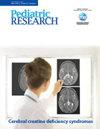新生儿呼吸监测的热点是什么?
IF 3.1
3区 医学
Q1 PEDIATRICS
引用次数: 0
摘要
影响:呼吸监测是新生儿常规临床护理的重要组成部分。最近的技术发展改进了呼吸监测,使监测参数和呼吸支持水平之间实现了双向互动。我们在此讨论神经调节通气辅助、闭环氧控制、潮气量呼吸监测、肺部超声波、膈肌电图和肺部磁共振成像监测的应用。本文章由计算机程序翻译,如有差异,请以英文原文为准。
What's hot in neonatal respiratory monitoring?
Impact: Respiratory monitoring is an essential part of routine clinical care of the newborn. Recent technological developments have improved respiratory monitoring and allowed for a two-way interaction between the monitored parameter and the level of the provided respiratory support. We herein discuss applications of monitoring by neurally adjusted ventilatory assist, closed-loop oxygen control, tidal capnography, lung ultrasound, diaphragmatic electromyography and lung magnetic resonance imaging.
求助全文
通过发布文献求助,成功后即可免费获取论文全文。
去求助
来源期刊

Pediatric Research
医学-小儿科
CiteScore
6.80
自引率
5.60%
发文量
473
审稿时长
3-8 weeks
期刊介绍:
Pediatric Research publishes original papers, invited reviews, and commentaries on the etiologies of children''s diseases and
disorders of development, extending from molecular biology to epidemiology. Use of model organisms and in vitro techniques
relevant to developmental biology and medicine are acceptable, as are translational human studies
 求助内容:
求助内容: 应助结果提醒方式:
应助结果提醒方式:


